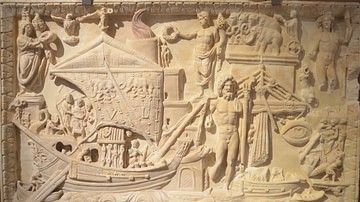Review

| Rating: | |
|---|---|
| Title: | Dolia: The Containers That Made Rome an Empire of Wine |
| Author: | Caroline Cheung |
| Audience: | University |
| Difficulty: | Medium |
| Publisher: | Princeton University Press |
| Published: | 2024 |
| Pages: | 344 |
The ancient Roman love for wine is well-known, but how was all that wine stored? In “Dolia,” Caroline Cheung puts dolia, the largest ceramic storage vessel made in the ancient world and capable of holding a thousand liters of wine, at the center of the ancient Roman wine trade for the first time. Best suited for scholars and students, this book explores the lifespan of dolia and the people who made, used, and paid for these massive vessels through a range of archaeological and literary evidence.
Caroline Cheung, an assistant professor of Classics at Princeton University, seeks to fill a rather large gap in the scholarship of the ancient Roman wine trade by centering the storage vessels themselves, the dolia (sing. dolium). Historically, these supermassive ceramic vessels, capable of holding well over a thousand liters each, have been understudied and overlooked. Combining various archaeological and literary evidence, Cheung argues that dolia formed the backbone for the Roman wine trade and that their development was the key factor in satisfying the Roman thirst for wine from the 2nd century BCE to the 2nd century CE. She pays particular attention to the many people involved in every step of the dolia industry and how dolia can function as a lens into the intersections of wealth, social mobility, and labor. The book focuses on three case-study sites in west-central Italy: Cosa, Pompeii, and Rome with its port Ostia.
Cheung organizes her book thematically to draw out each step in the life of a dolium. After the introduction, Chapter Two traces the development of the dolia industry from the 2nd century BCE to the height of the Roman Empire. Chapters Three to Six detail the various uses of dolia on farms and villas, as part of a complex trade system in the Mediterranean, and cities. Chapters Seven and Eight then turn to how dolia were maintained, repaired, and eventually reused and abandoned. Cheung concludes in Chapter Nine with reflections on studying dolia and their legacy today.
Cheung does a masterful job of marshaling a truly staggering amount of archaeological and literary evidence to make this book possible. From the largest dolium-tanker shipwrecks to the smallest epigraphic stamps and tax records, Cheung excels at drawing out the particular importance of each piece of evidence. Some of the most interesting moments in the book are when she slows down to focus on a specific site or detail amidst the wealth of information she provides, such as in Chapter Four, when she draws out the story of the Sestius and Piranus families as examples of how wealthy families could take advantage of different stages in a dolia-based wine trade to accrue wealth and influence. A slate of images and figures also complements her prose well, including full-color plates of many images in the book.
At times, however, Cheung seems to struggle with her two competing priorities of exploring the life of a dolium from production to abandonment and examining the ramifications of dolia on the Roman wine trade and Roman imperialism more broadly. Her prose sometimes switches quite abruptly between the two, leaving the reader to try to pull together disparate threads of the narrative. In focusing mainly on west-central Italy, with only a brief foray into southern France and Spain, Cheung’s narrative can feel quite restricted, leaving out as it does the rest of the Mediterranean world, let alone the rest of the Roman Empire. Some discussion of what we do know about dolia outside of the book's case study areas would have been worthwhile to help provide a fuller picture of the role of dolia across the Mediterranean. As the first step in synthesizing much of this material, this book is a very needed addition in illuminating the crucial role dolia played in the Roman wine trade.
Cheung is one of the few scholars working on dolia currently, and perhaps the only one synthesizing the material on such a broad level, and her mastery of the material shows in this book. In centering dolia in the narrative of the Roman wine trade, Cheung takes a completely different tact to previous studies of this topic with great results. She argues persuasively why dolia deserve to be seen front and center in future scholarship. This book demonstrates the value of studying the logistics of the Roman wine trade just as much as the Romans’ love of wine itself.
About the Reviewer
Cite This Work
APA Style
Hagler, A. (2024, July 25). Dolia: The Containers That Made Rome an Empire of Wine. World History Encyclopedia. Retrieved from https://www.worldhistory.org/review/465/dolia-the-containers-that-made-rome-an-empire-of-w/
Chicago Style
Hagler, Alex. "Dolia: The Containers That Made Rome an Empire of Wine." World History Encyclopedia. Last modified July 25, 2024. https://www.worldhistory.org/review/465/dolia-the-containers-that-made-rome-an-empire-of-w/.
MLA Style
Hagler, Alex. "Dolia: The Containers That Made Rome an Empire of Wine." World History Encyclopedia. World History Encyclopedia, 25 Jul 2024, https://www.worldhistory.org/review/465/dolia-the-containers-that-made-rome-an-empire-of-w/. Web. 04 Jul 2025.




